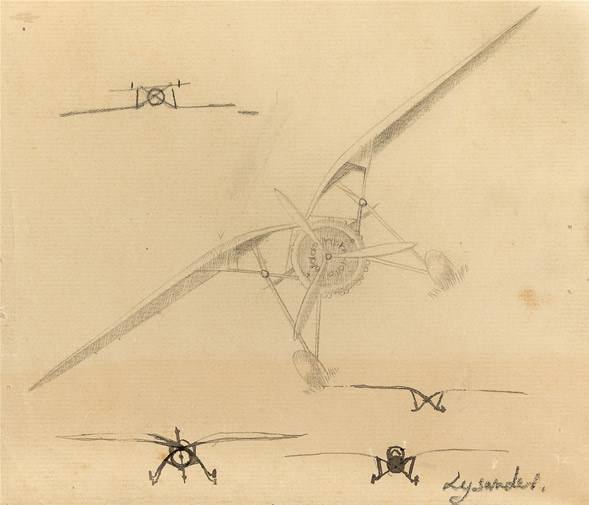
 SOLD
SOLD
Sir Thomas Monnington:
Lysander, circa 1942
Framed (ref: 1043)
Inscribed and titled by the artist's son, John.
In a square section gilded oak frame with broad oak inner slip, pencil and pen and ink on tracing paper, 5 1/8 x 6 1/4 in. (13 x 16 cm.)
Tags: Sir Thomas Monnington ink pen and ink pencil war
Monnington was passionate about aircraft - by the time he applied to become an official War Artist he had completed over 600 hours of flying time, having worked
during the early part of the war in the Design Team of the Directorate of Camouflage. Whilst posted at the
Brooklands race track he met Barnes Wallis – inventor of the Wellington Bomber
and the bouncing bomb – who asked Monnington to apply his talent to improving
the appearance of a heavy bomber which was being developed at the time, (two
designs for which are in the collection of the Victoria & Albert Museum). Much
in the same vien the Lysander shown here is a developmental design –
Monnington’s view of what an enhanced Lysander might look like. Lydansers were used in the early part of the war for dropping SIS officers into France, the very long undercarriage and wide
wheel base allowing for landing
in fields at speeds as slow as 40 mph. The Royal Air Force (Handbook) by Eric Sargeant, circa 1941, descirbes The Lysander as follows:
a
very fine aeroplane which has performed many diverse operations during
this war. Among its duties are reconnaissance, artillary spotting,
delivery of food and ammunition, etc. to beleaguered troops,
message-dropping and picking-up, light boming etc. Monnington's enhanced design shows elongated wings and a wider wheel base.We are grateful to John Monnington for assistance.







